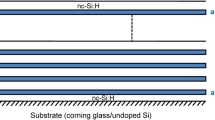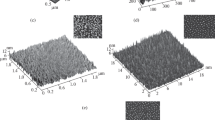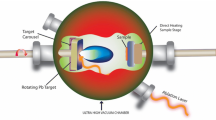Abstract
In-situ X-ray diffraction is used to study the structure of Pb nanocrystalline islands grown on Si(111)7 × 7. The coverage dependence of the (0,8/7) surface reflection demonstrates that when the Pb nanocrystals nucleate, they consume the wetting layer. Concomitantly, the nanocrystals move away from the Si substrate and exhibit two-dimensional mosaicity in the substrate plane, while maintaining nearly perfect orientation in the direction perpendicular to the plane. These results, along with the fact that the nanocrystal interface is very smooth despite the highly corrugated substrate, indicate that the nanocrystals decouple from the Si substrate and provide an excellent interface to support electron standing waves that are needed for quantum-size effects (QSEs).
Similar content being viewed by others
Avoid common mistakes on your manuscript.
1 Introduction
The discovery of quantum-size effects (QSEs) in Pb nanocrystals grown on the Si(111) substrate has attracted considerable interest because of the novel properties they exhibit.[1] Through a Stranski–Krastanov growth mode, thin pancake-shaped islands form after the completion of one monolayer (ML) of Pb. These nanocrystalline islands exhibit “magic” heights that are related to the quantum confinement of the conduction electrons. Indeed, these confinement states have been observed in photoemission experiments.[2] Recent X-ray scattering experiments have shown novel coarsening behavior due to the breakdown of the Gibbs–Thomson effect when there are QSEs.[3] The same studies also demonstrated anomalously fast kinetics that are at least three orders of magnitude faster than expected as compared to larger crystals. The fast kinetics is essential for observing island morphologies determined by minimum energy considerations rather than by kinetic limitations that are generally employed for understanding epitaxial crystal growth.
At present, there is little understanding of the role of the Pb/Si interface, which impacts three important aspects of QSE in this system: (1) the interfacial energy relative to the confinement energy, (2) the effect of the interfacial structure on the electron standing waves, and (3) the role that the interface plays in changing the kinetics of growth. Each of these issues is important to understand in order to have a clear picture of why and how QSE occurs in this system, as well as how we might expect these results to be manifested in other systems. Previously, we have suggested that, once formed, the nanocrystals consume the wetting layer and pull away from the substrate.[4–6] In this article, we present new data that more directly supports these conclusions. Collectively, these results lead to the conclusion that the Pb nanocrystals are quite decoupled from the substrate.
2 Experimental Details
The experiments were performed in the ultrahigh vacuum chamber for surface scattering studies at the MUCAT sector 6 beamline at the Advanced Photon Source. The Si(111) substrates (n type; resistivity is 0.1 to 10 Ω cm) were outgassed for at least 6 hours at 600 °C and allowed to cool before flash annealing to 1200 °C and slow cooled from 900 °C to room temperature. This procedure provides a high-quality 7 × 7 reconstructed surface with a surface mosaic width, measured with X-rays, of just a few hundredths of a degree. The Pb was deposited from an Omicron EFM3 electron-beam evaporator with the substrate held at 208 K. The Pb coverages are quoted in terms of bulk Pb monolayers.
3 Results and Discussion
Upon deposition, a 1 ML wetting layer forms, which is highly disordered because of the underlying 7 × 7 reconstruction of the Si. At present, the best estimate of the wetting layer structure is that it is an 8 × 8 unit cell within the Si 7 × 7 cell.[7] Because of the mismatch and the Si adatom layer, there are considerable vertical fluctuations in the structure. Above 1 ML of coverage, Pb nanocrystals form and in-plane as well as out-of-plane reflections can be observed corresponding to fcc Pb.[4–6] Our studies of the Pb(111) Bragg reflection, which is oriented perpendicular to the surface, have found two important features of the vertical structure upon the growth of the nanocrystals.[4–6] First, as indicated in Figure 1, the interfacial distance between the Pb and the Si substrate is 0.3 to 0.4 Å larger for the nanocrystal than for the wetting layer. Second, the vertical displacement disorder of the Pb nanocrystal is significantly diminished in comparison to the wetting layer. These results suggest that the nanocrystals incorporate the wetting layer beneath it; otherwise, the nanocrystals would possess a smooth interface on top of a vertically rough Pb wetting layer, which is unlikely.
We now present new evidence that is considerably more direct in showing that the wetting layer is consumed by the nanocrystal. Figure 2 shows the (0,8/7) intensity, measured in grazing incidence geometry, as a function of Pb coverage. Although this surface reflection is present for the Si(111)7 × 7 reconstructed surface, it becomes extremely intense at 1 ML of Pb coverage because the 8 × 8 Pb unit cell of the wetting layer fits within the reconstructed substrate unit cell. Above 1 ML, the intensity rapidly decreases as the nanocrystals form, directly indicating the disappearance of the wetting layer. This means that there is no longer a wetting layer underneath the nanocrystalline island, and this is an important distinction in the context of the Stranski–Krastanov growth mode, which generally assumes that islands exist on top of a strained wetting layer. At very high coverage, when the nanocrystals have coalesced, the slower intensity decay is due to the photoelectric absorption of X-rays from the Pb film. Extrapolating this line back to zero coverage indicates an intensity that is slightly higher than the starting Si(111)7 × 7 intensity, suggesting that the 7 × 7 reconstruction is only slightly perturbed by the Pb.
Coverage dependence of the (0,8/7) surface reflection measured by grazing incidence X-ray diffraction. The intensity is maximum at 1 ML coverage, corresponding to the completion of the wetting layer. The subsequent intensity decay is due to nanocrystalline islands consuming the wetting layer beneath them. The intensity decay above 10 ML coverage is due to photoelectric absorption of the X-rays due to islands coalesced into a Pb film
We now turn to the in-plane structure of the nanocrystalline islands. Radial scans performed in plane show a sharp diffraction peak for fcc Pb\( \left( {2\bar{2}0} \right) \), and this occurs at a position corresponding to the bulk Pb lattice constant; thus, the Pb nanocrystal is incommensurate with the substrate. Concomitantly, we observe a large mosaicity in transverse scans through the Bragg reflection. As shown in Figure 3, the mosaicity is quite large, on the order of 15 deg, indicating large two-dimensional rotational fluctuations in the orientation of the nanocrystals. The out-of-plane Pb(111) reflection remains sharp and does not exhibit this mosaicity. In fact, it exhibits a two-component line shape: one that is resolution limited and another that is the diffuse scattering from island-island correlations. This latter diffuse scattering was, in fact, used to measure island coarsening.[3] Thus, we conclude that islands maintain a high degree of orientation perpendicular to the surface, while exhibiting large orientational fluctuations in the plane.
4 Summary
We now have a clear understanding of how the nanocrystals evolve from the wetting layer. First, without the benefit of Pb neighbors, the Pb atoms in the 1 ML wetting layer exhibit short bond lengths with the Si substrate. However, once the nanocrystal forms, the Pb that was once in the wetting layer then incorporates into the fcc structure of the nanocrystal and the Si-Pb bond length dramatically increases. The results in Figure 2 provide the first direct evidence that the wetting layer is consumed by the nanocrystals. At the same time, X-ray reflectivity shows that the nanocrystal-Si interface becomes very smooth, while in-plane diffraction shows a large two-dimensional mosaicity. The effect of the nanocrystals on the Si(111)7 × 7 reconstructed surface appears relatively small. Taken together, these results indicate that the Pb nanocrystals are quite decoupled from the substrate and “float” on top of it. The smooth interfaces on both sides of the nanocrystal permit well-defined boundary conditions for the electron standing waves that give rise to QSE, while a weak interaction with the substrate causes minimal perturbation to these energy levels.
References
M. Hupalo, S. Kremmer, V. Yeh, L. Berbil-Bautista, E. Abram, and M.C. Tringides: Surf. Sci., 2001, vol. 493, p. 526.
M.H. Upton, C.M. Wei, M.Y. Chou, T. Miller, and T.-C. Chiang: Phys. Rev. Lett., 2004, vol. 93, pp. 026802–05.
C.A. Jeffrey, E.H. Conrad, R. Feng, M. Hupalo, C. Kim, P.J. Ryan, P.F. Miceli, and M.C. Tringides: Phys. Rev. Lett., 2006, vol. 96, pp. 106105–08.
R. Feng, E.H. Conrad, M.C. Tringides, C. Kim, and P.F. Miceli: Appl. Phys. Lett., 2004, vol. 85, pp. 3866–68.
C.A. Jeffrey, R. Feng, E.H. Conrad, P.F. Miceli, C. Kim, M. Hupalo, M.C. Tringides, and P.J. Ryan: Superlattice. Microst., 2007, vol. 41, pp. 168–77.
R. Feng, E.H. Conrad, C.A. Jeffrey, C. Kim, M.W. Gramlich, S.T. Hayden, and P.F. Miceli: 2009, unpublished research.
R. Feidenhans’l, F. Grey, M. Nielson, and R.L. Johnson: in Kinetics of Ordering and Growth at Surfaces, NATO ASI Series, M.G. Lagally, ed., Plenum Press, New York, 1990, pp. 189–207.
Acknowledgments
Funding from the following sources is gratefully acknowledged: the National Science Foundation Grant No. DMR-0706278 and the Petroleum Research Fund Grant No. 41792AC10 (MWG, STH, CAJ, and PFM); the Seoul Research and Business Development Program Grant No. 10583 (CK); Canim Scientific (EHC); and the Natural Sciences and Engineering Research Council (NSERC) of Canada (CAJ). The Advanced Photon Source is supported by the United States Department of Energy (US DOE) Office of Basic Energy Sciences, Contract No. W-31-109-Eng-38. The MUCAT beam line is supported through the Ames Lab, operated for the US DOE by Iowa State University under Contract No.W-7405-Eng-82.
Author information
Authors and Affiliations
Corresponding author
Additional information
This article is based on a presentation given in the symposium “Neutron and X-Ray Studies of Advanced Materials,” which occurred February 15–19, 2009, during the TMS Annual Meeting in San Francisco, CA, under the auspices of TMS, TMS Structural Materials Division, TMS/ASM Mechanical Behavior of Materials Committee, TMS: Advanced Characterization, Testing, and Simulation Committee, and TMS: Titanium Committee.
Rights and permissions
Open Access This is an open access article distributed under the terms of the Creative Commons Attribution Noncommercial License ( https://creativecommons.org/licenses/by-nc/2.0 ), which permits any noncommercial use, distribution, and reproduction in any medium, provided the original author(s) and source are credited.
About this article
Cite this article
Gramlich, M.W., Hayden, S.T., Jeffrey, C.A. et al. Interface between Quantum-Size-Effect Pb Nanocrystals and the Si(111)7 × 7 Substrate: an X-Ray Diffraction Study. Metall Mater Trans A 41, 1159–1161 (2010). https://doi.org/10.1007/s11661-009-0034-8
Published:
Issue Date:
DOI: https://doi.org/10.1007/s11661-009-0034-8







